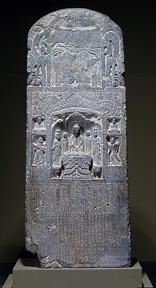
Dated 549 CE
China, Western Wei dynasty (535-557 CE)
Limestone
Height: 167.5 cm
Acquisition number: #B62 S2+
The Avery Brundage Collection
Image courtesy of the Asian Art Museum of San Francisco.
Copyright reserved.
"Stele" is a term for an upright stone post or tablet engraved with inscriptions or designs that serves as a monument or marker. In a Buddhist context, stelae were used to promote religious instruction and supply religious imagery. The reproduction of Buddhist texts and icons is considered a pious act in the Mahayana tradition, and so during Northern Wei period and the subsequent Wei dynasties in China, it became very common for donors to commission the creation of stele in order to generate spiritual merit for themselves.
The stele reproduced here is engraved with detailed information about the donors who paid for its creation, as well as a date (549). The donors were from Taiping (in modern Shanxi province), and their names appear on the sides and on the bottom of the tablet. The most important patrons had the honor of having both their names and a simple portrait appear on the front of the stele, on the lower register (view Detail 1).
The middle register is occupied by a scene of the Western Paradise (view Detail 2). By creating a votive stele honoring Amitabha, the donors hoped to be reborn in this Paradise in the presence of the Buddha Amitabha and his attending bodhisattvas, Avalokitesvara and Mahasthamaprapta, who stand on lotus blossoms on either side of the Buddha (read more about Amitabha and his Paradise).
The upper register (view Detail 3) illustrates a popular story in Mahayana Buddhism concerning a debate between Vimalakirti, a wealthy merchant, was known for his knowledge of Buddhist scriptures, and Manjusri, the bodhisattva of wisdom. According to the tale, Vimalakirti was able to defeat Manjusri in a debate about Buddhist law, proving that it was possible to achieve a high state of understanding and insight into the Buddhist faith without taking the tonsure. This was an important message for proselytizers, for it reassured lay people that it was not necessary for one to give up ones worldly responsibilities in order to be a good Buddhist.